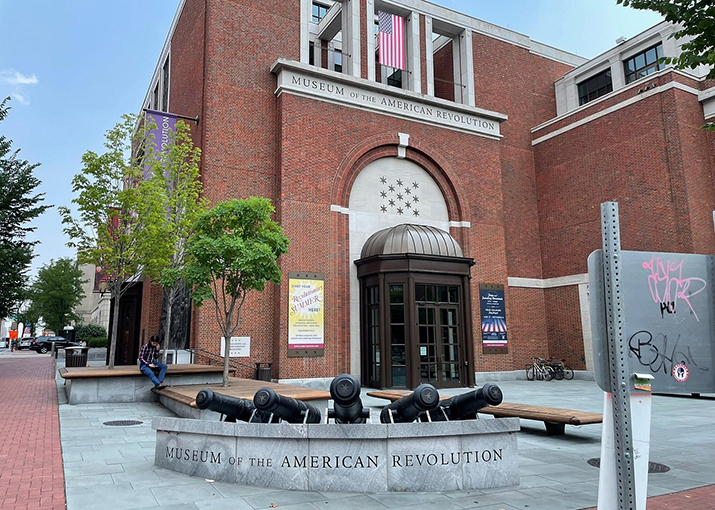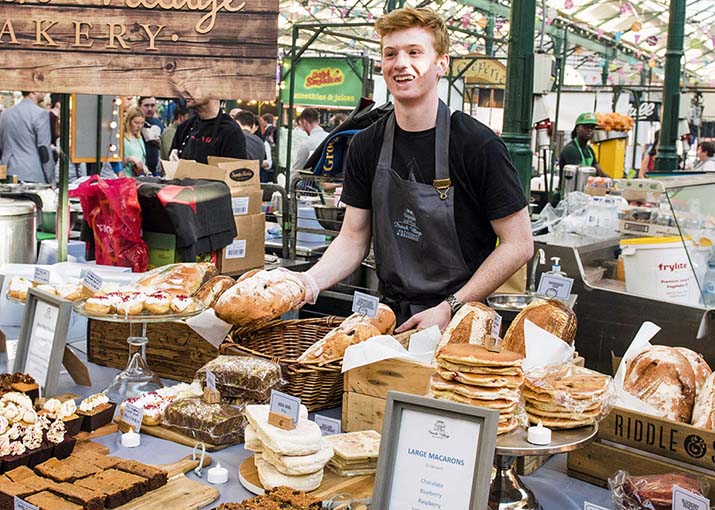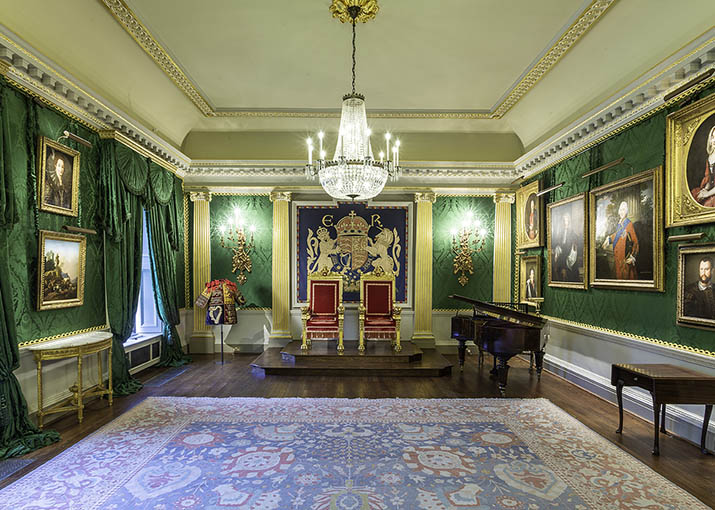This institution, nestled just steps away from Independence Hall, offers a profound journey through the tumultuous era of America’s fight for independence. With its unparalleled collection of Revolutionary-era weapons, personal artifacts, documents, and artworks, the museum unveils the dramatic and astonishing stories of the American Revolution. Through immersive galleries, powerful theater experiences, and interactive digital elements, visitors from all walks of life are transported back in time to witness the incredible hardships overcome by individuals who forged a new nation.
Exploring the Galleries:
Upon entering the Museum of the American Revolution, visitors are immediately enveloped in the sights and sounds of the Revolutionary era. The galleries are meticulously curated to guide guests through the chronological unfolding of events, from the early stirrings of discontent to the final triumph of independence. Each exhibit is thoughtfully designed to provide insight into the motivations, struggles, and triumphs of the revolutionaries.
One of the most captivating aspects of the museum is its collection of Revolutionary-era weapons. Displayed with meticulous detail, these artifacts offer a tangible connection to the challenges faced by soldiers on both sides of the conflict. From muskets and bayonets to cannons and swords, each weapon tells a story of courage and sacrifice.
In addition to weapons, the museum houses a vast array of personal items belonging to Revolutionary figures. These artifacts offer a glimpse into the daily lives of individuals who played pivotal roles in shaping the course of history. From George Washington’s camp stool to Abigail Adams’ letters, these items humanize the revolutionaries, making their struggles and triumphs feel more immediate and relatable.
As I wandered through the museum’s halls, I was struck by the intimacy and immediacy of these artifacts, each one bearing witness to the hopes, fears, and aspirations of the revolutionaries. The sight of George Washington’s worn camp stool, for instance, transported me back in time, offering a glimpse into the quiet moments of reflection and resolve that defined his leadership on the battlefield.

Similarly, the sight of Abigail Adams’ handwritten letters provided a window into the personal struggles and triumphs of the women who supported the Revolutionary cause from afar. As I read her words, penned with love and determination, I couldn’t help but feel a sense of admiration for her resilience and strength in the face of adversity.
But it wasn’t just the famous figures of the Revolution who were represented in the museum’s collection—there were also countless artifacts belonging to ordinary men and women who had played their own small but significant roles in the fight for freedom. From soldiers’ uniforms to family heirlooms passed down through generations, each item told a story of sacrifice, resilience, and hope.
In this way, the museum’s collection of personal artifacts served to humanize the revolutionaries, bridging the gap between past and present and making their struggles and triumphs feel more immediate and relatable. By preserving these tangible connections to the past, the museum ensures that the legacy of the Revolution lives on, inspiring future generations to cherish the freedoms that were won through sacrifice and determination.
Theater Experiences:
One of the highlights of my visit to the Museum of the American Revolution was the powerful theater experiences offered throughout the exhibits. These immersive presentations bring key moments of the Revolution to life, allowing visitors to witness history unfold before their eyes.
One particularly memorable theater experience was the reenactment of the signing of the Declaration of Independence. Set against a backdrop of soaring music and dramatic lighting, the scene transported me back to that fateful day in 1776 when brave patriots risked everything to declare their independence from tyranny. As I watched the actors recite the stirring words of the Declaration, I couldn’t help but feel a sense of awe at the courage and conviction of those who signed it.
Another standout theater experience was the recreation of key battles from the Revolutionary War. Through stunning visual effects and heart-pounding sound design, these presentations vividly capture the chaos and intensity of combat. As I watched soldiers charge into battle and cannons roar, I gained a newfound appreciation for the sacrifices made by those who fought for freedom.
As I watched in awe, soldiers charged into battle with unwavering determination, their uniforms billowing in the wind as they fought for liberty and independence. The thunderous roar of cannons reverberated through the theater, shaking me to my core and immersing me in the tumultuous atmosphere of war.
But it was not just the spectacle of battle that left a mark on me—it was the realization of the sacrifices made by those who fought for freedom. With each scene unfolding before my eyes, I gained a newfound appreciation for the bravery and resilience of the men and women who stood up against tyranny and oppression.
Through the lens of theater, I was able to witness history come alive, gaining a deeper understanding of the struggles and triumphs that shaped our nation. It was a powerful reminder of the enduring legacy of the Revolutionary War and the values for which our forefathers fought so bravely.
As I left the theater, the echoes of battle still ringing in my ears, I couldn’t help but feel a sense of gratitude for the freedoms that we enjoy today. The recreation of these key battles had not only entertained and captivated me but had also touched my heart, leaving me with a profound appreciation for the sacrifices made by those who came before us.
Interactive Digital Elements:

In addition to its traditional exhibits and theater experiences, the Museum of the American Revolution also boasts a range of interactive digital elements that engage visitors in new and exciting ways. From touch-screen displays to immersive virtual reality simulations, these interactive features offer deeper insights into the events and personalities of the Revolution.
One of the most fascinating digital elements is the museum’s interactive map, which allows visitors to explore key locations and battles of the Revolutionary War. By zooming in on specific areas, users can access detailed information about each battle, including troop movements, strategies, and outcomes. This interactive map provides a valuable educational tool for visitors of all ages, helping them gain a better understanding of the geography and tactics of the Revolution.
Another innovative feature is the museum’s virtual reality experience, which transports visitors into the shoes of a Revolutionary soldier. Through the use of VR headsets, users can immerse themselves in the sights and sounds of battle, gaining a firsthand perspective on the challenges faced by soldiers on the front lines. This virtual reality experience offers a visceral reminder of the human cost of war, fostering empathy and understanding among visitors.
As I donned the VR headset and stepped into the virtual world, I was immediately struck by the realism of the experience. The chaotic sounds of musket fire and cannon blasts surrounded me, while the sights of fellow soldiers charging into battle and smoke billowing from cannons filled my field of vision.
But it was not just the sensory immersion that made the VR experience so impactful—it was the sense of empathy and understanding that it fostered among visitors. By placing them directly in the shoes of a Revolutionary soldier, the VR experience provided a visceral reminder of the human cost of war, allowing participants to gain a deeper appreciation for the sacrifices made by those who fought for freedom.
As I navigated through the virtual battlefield, I couldn’t help but feel a sense of awe and reverence for the bravery and resilience of the soldiers who had come before me. Their courage in the face of adversity served as a powerful testament to the indomitable spirit of the American Revolution, leaving me with a newfound sense of gratitude for the freedoms that we enjoy today.
In addition to its entertainment value, the museum’s virtual reality experience served as an educational tool, offering visitors a unique opportunity to engage with history in a meaningful and immersive way. By bridging the gap between past and present, it encouraged reflection and dialogue on the enduring legacy of the Revolutionary War, ensuring that its lessons would not be forgotten.
The museum’s virtual reality experience was a standout feature that left a lasting impression on me, deepening my understanding of history and inspiring me to honor the sacrifices of those who came before us. It was a powerful reminder of the human stories behind the battles and a testament to the museum’s commitment to engaging and enlightening its visitors.
As I made my way through the Museum of the American Revolution, I couldn’t help but be struck by the enduring relevance of its message. At a time when the ideals of liberty, equality, and democracy are facing new challenges, the stories of the Revolution serve as a powerful reminder of the importance of standing up for what is right. The museum’s exhibits inspire visitors to reflect on their own roles in upholding these ideals and to consider the ways in which they can contribute to a more just and equitable society.
My visit to the Museum of the American Revolution was a deeply enriching and thought-provoking experience. Through its unparalleled collection, immersive theater experiences, and interactive digital elements, the museum offers a multifaceted exploration of one of the most pivotal periods in American history. By shedding light on the struggles and triumphs of the revolutionaries, the museum inspires visitors to reflect on their own commitments to the principles of freedom and democracy. As I left the museum, I felt a renewed sense of appreciation for the sacrifices made by those who came before us and a determination to carry their legacy forward into the future.


